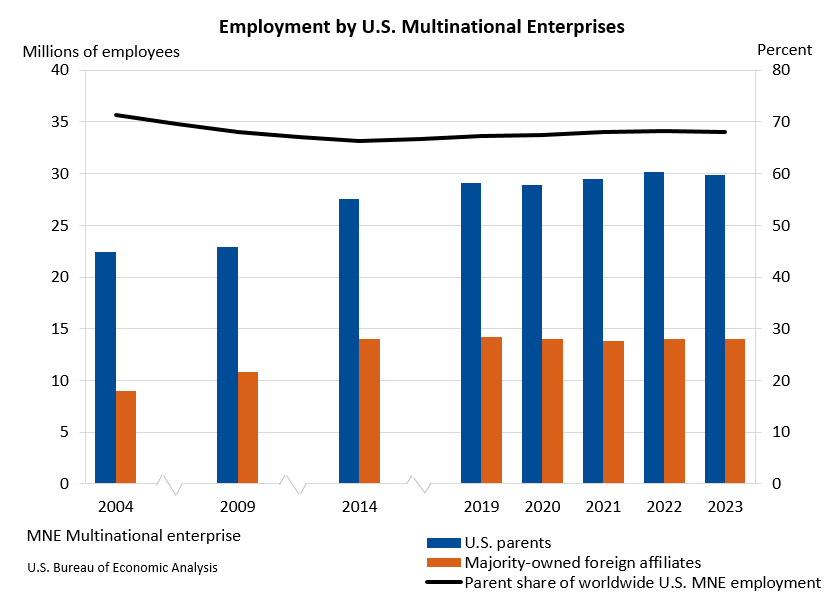Bureau of Economic Analysis
Activities of U.S. Multinational Enterprises, 2023
Worldwide employment by U.S. multinational enterprises decreased 0.4 percent to 43.9 million workers in 2023 (preliminary) from 44.1 million workers in 2022 (revised), according to statistics released today by the U.S. Bureau of Economic Analysis on the operations and finances of U.S. parent companies and their foreign affiliates.
Principal Federal Economic Indicators
Noteworthy
- 2025 News Release Schedule
- Innovation at BEA
- 2025 Annual Updates
- Distribution of Personal Income Nowcast
- New! Services Trade Data for More Countries
- Data Tool: Trade in Value Added
- Updated: RIMS II Regional Multipliers
- Arts and Culture
- Space Economy
- FDI Now in State BEARFACTS
- Quick Guide: Price Indexes
The Latest
Industry in Focus: Construction on the Rise
Although the U.S. economy has changed considerably over time, construction is an industry that’s maintained its importance. We no longer depend on telegraphs as we once did, but we’ll always need a place to live. Construction also is an industry in which the products can differ to a great degree. While cellphones may be quite similar to one another, office buildings take shapes ranging from the Empire State Building to a one-story structure…
Gross Domestic Product by Industry: First Quarter 2016
Construction; health care and social assistance; and retail trade were the leading contributors to the increase in U.S. economic growth in the first quarter of 2016. Overall, 11 of 22 industry groups contributed to the 1.1 percent increase in real GDP in the first quarter.
Gross Domestic Product by Industry, 1st quarter 2016
Construction; health care and social assistance; and retail trade were the leading contributors to the increase in U.S. economic growth in the first quarter of 2016. According to statistics on the breakout of gross domestic product (GDP) by industry released by the Bureau of Economic Analysis, 11 of 22 industry groups contributed to the overall 1.1 percent increase in real GDP in the first quarter.
What's New for the 2016 Annual GDP Update?
The Bureau of Economic Analysis updates GDP figures and their major components every summer, sweeping in more comprehensive data that weren’t available for earlier estimates. The 2016 annual update, coming July 29, also will feature some of BEA’s efforts to continuously improve its measurement of the U.S. economy.
Summer updates to national income and product accounts incorporate data from annual Census Bureau surveys of businesses…
Guest blog: New Advance Economic Indicators Report Available This Month
This is a guest blog by John H. Thompson, Director of U.S. Census Bureau
New Foreign Direct Investment in the United States, 2014 and 2015
Expenditures by foreign direct investors to acquire, establish, or expand U.S. businesses totaled $420.7 billion in 2015, an increase of 68 percent from 2014, when expenditures were $250.6 billion; according to the Bureau of Economic Analysis (BEA) in statistics released today.
Some additional highlights of the statistics on new foreign direct investment for 2015:
New Foreign Direct Investment in the United States, 2014 and 2015
Expenditures by foreign direct investors to acquire, establish, or expand U.S. businesses totaled $420.7 billion in 2015, an increase of 68 percent from 2014, when expenditures were $250.6 billion. In 2015, as in 2014, the majority of the expenditures were to acquire existing businesses. In 2015, expenditures for acquisitions were $408.1 billion. Expenditures to establish new U.S. businesses were $11.2 billion, and expenditures to expand…
Real Personal Income for States, 2014
Real personal income across all regions rose by an average of 2.9 percent in 2014. This growth rate reflects the year-over-year change in nominal personal income across all regions adjusted by the change in the national personal consumption expenditures (PCE) price index. On a nominal basis, personal income across all regions grew an average of 4.4 percent in 2014. In 2014, the U.S. PCE price index grew 1.4 percent.
Real Personal Income for States and Metropolitan Areas
Real personal income across all regions rose by an average of 2.9 percent in 2014. This growth rate reflects the year-over-year change in nominal personal income across all regions adjusted by the change in the national personal consumption expenditures (PCE) price index. On a nominal basis, personal income across all regions grew an average of 4.4 percent in 2014. In 2014, the U.S. PCE price index grew 1.4 percent.
May 2016 Trade Gap is $41.1 Billion
The U.S. monthly international trade deficit increased in May 2016 according to the U.S. Bureau of Economic Analysis and the U.S. Census Bureau. The deficit increased from $37.4 billion in April (revised) to $41.1 billion in May, as exports decreased and imports increased. The previously published April deficit was $37.4 billion. The goods deficit increased $3.7 billion from April to $62.2 billion in May. The services surplus decreased $0.1…




